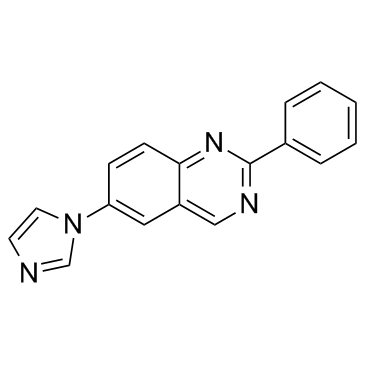1004997-71-0
| Name | 6-(1H-Imidazol-1-yl)-2-phenylquinazoline |
|---|---|
| Synonyms |
Quinazoline, 6-(1H-imidazol-1-yl)-2-phenyl-
6-(1H-Imidazol-1-yl)-2-phenylquinazoline CR4056 |
| Description | CR4056 is a selective inhibitor of human recombinant MAO-A with an IC50 of 202.7 nM. CR4056 is also a ligand of imidazoline-2 receptor (I2R) with an IC50 of 596 nM. |
|---|---|
| Related Catalog | |
| Target |
IC50: 202.7 nM (MAO-A), 596 nM (I2R)[1] |
| In Vitro | CR4056 is an imidazoline-2 receptor (I2R) ligand with an IC50 of 596±76 nM. CR4056 is also an inhibitor of both human recombinant MAO-A and MAO-B with IC50s of 202.7±10.3 and >10000, respectively[1]. The co-treatment of bortezomib (BTZ) with CR4056 at all the concentrations used (range 3 to 30 μM) does not induce any significant difference in cell survival compare with BTZ-treated cells, either in H929 or in RPMI 8226 myeloma cells[2]. |
| In Vivo | Two hours after a single oral dose of 20 mg/kg CR4056, endogenous norepinephrine (NE) levels increase by 68.2%±14.1% (P<0.05 versus vehicle) in the parieto-occipital cortex. Sub-chronic (four days) oral treatment with 20 mg/kg CR4056 once daily, significantly increases NE levels both in the cerebral cortex (63.1%±4.2%; P<0.05 versus vehicle) and in the lumbar spinal cord (51.3%±6.7%; P<0.05 versus vehicle). CR4056 dose-dependently reduces mechanical hyperalgesia (effective dose [ED50]=5.8 mg/kg) (P<0.001). CR4056 (10 mg/kg) and piroxicam (10 mg/kg) significantly reverse the decrease in withdrawal threshold caused by capsaicin (P<0.001 versus vehicle). The highest tested dose of CR4056 (30 mg/kg) completely reverses the effect of capsaicin, increasing paw withdrawal threshold (PWT) to 239±12 g (P<0.001 versus vehicle) after 1 hour. CR4056 dose-dependently decreases streptozotocin (STZ)-induced diabetic pain in rats (F[4, 35]=31.27, P<0.001). CR4056 significantly increases the mechanical withdrawal thresholds of both ipsilateral (F[4, 30]=19.97, P<0.001) and contralateral (F[4, 30]=31.58, P<0.001) hind paws compare with vehicle control[1]. |
| Kinase Assay | Binding assays on monoamine oxidases in rat cerebral cortical membranes are conducted. In summary, for the MAO-A binding assay, tritiated N-(2-aminoethyl)-5-(m-fluorophenyl)-4-thiazole carboxamide HCl ([3H]Ro 41-1049, 10 nM) is incubated in the absence or presence of CR4056 for 60 minutes at 37°C and non specific binding is determined in the presence of 1 μM clorgyline. For the MAO-B binding assay, incubation of [3H]Ro 19-6327(tritiated lazabemide) (15 nM) is carried out for 90 minutes at 22°C and non specific binding is determined in the presence of 10 μM (R)-deprenyl [1]. |
| Cell Assay | To rule out any interference of CR4056 with bortezomib (BTZ)-induced cytotoxicity, non-small cell lung cancer and MM cell lines are simultaneously treated for 72 hours with BTZ and CR4056. Cells are exposed to the IC50 of BTZ, estimated in the cytotoxicity study, with or without three concentrations of CR4056 (3, 10, and 30 μM). The incubations with CR4056 alone (3, 10, and 30 μM) and with the highest dose of vehicle (DMSO) are also performed. Growth inhibition is assessed by MTT assay. In these experiments, the CR4056 is tested in vitro in a range of concentrations spanning from pharmacological to toxicological levels[2]. |
| Animal Admin | Rats: Rats are fasted overnight before drug administration. A first measurement of pain threshold is undertaken before capsaicin injection. Capsaicin is administered at time t=0 by the intraplantar route in the right hind paw (10 μL of a 1 mg/mL Tween 80/saline solution). Sixty minutes later, animals are dosed by the oral route with CR4056 (3 to 30 mg/kg) or its vehicle in a volume of 5 mL/kg. A sham control group is always present for comparison. In mechanistic studies, antagonists are administered 30 minutes after capsaicin and 15 minutes before CR4056 administration[1]. |
| References |
| Density | 1.3±0.1 g/cm3 |
|---|---|
| Boiling Point | 364.1±24.0 °C at 760 mmHg |
| Molecular Formula | C17H12N4 |
| Molecular Weight | 272.304 |
| Flash Point | 174.0±22.9 °C |
| Exact Mass | 272.106201 |
| LogP | 3.09 |
| Vapour Pressure | 0.0±0.8 mmHg at 25°C |
| Index of Refraction | 1.699 |
| Storage condition | 2-8℃ |
